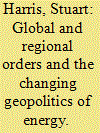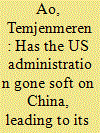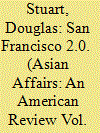| Srl | Item |
| 1 |
ID:
094042


|
|
|
|
|
| Publication |
2010.
|
| Summary/Abstract |
Attention by international relations scholars to the transformation underway stemming from the rise of China has not been matched by that given to the transformation underway in the international energy system. This article looks at three dimensions of that transformation: the end of cheap oil and the rising trend of energy prices; the changing role of the traditional international oil companies and the rise of national oil companies; and the growing energy importance of the Middle East and Russia. It looks at how these changes have already affected or are likely to affect three strategic relationships: US-Middle East; US-China; and Europe-Russia-US. It concludes that more attention needs to be given by scholars to what will be major changes in global geopolitical relationships with considerable consequences for the foreign policies of the major powers.
|
|
|
|
|
|
|
|
|
|
|
|
|
|
|
|
| 2 |
ID:
142346


|
|
|
| 3 |
ID:
086311


|
|
|
|
|
| Publication |
2009.
|
| Summary/Abstract |
In the history of US-China wartime relations, the Stilwell Incident has become 'hard evidence' that the Nationalist Government had no intention of fighting against Japan and would exploit Allied resources to expand its strength. Interestingly enough, Stilwell's successor, Albert C. Wedemeyer, despite taking command in a difficult and awkward situation, succeeded in strengthening the Nationalist armies to fight the Japanese and kept Sino-American relations out of a state of crisis. With the availability of Chiang Kai-shek's newly-released diaries and the Wedemeyer Papers, historians are now in a good position to explore how and why Wedemeyer could successfully fulfill his mission. The basis of Wedemeyer's success becomes clear upon close examination of his perception of and attitude toward the Chinese situation and of his dealings with Chiang Kai-shek, the ongoing offensive of the Japanese troops, and KMT-CCP conflicts. Wedemeyer's case provides insight into the nature of the US-China wartime relationship.
|
|
|
|
|
|
|
|
|
|
|
|
|
|
|
|
| 4 |
ID:
117651


|
|
|
|
|
| Publication |
2012.
|
| Summary/Abstract |
This is the third time that American policy makers have considered a pivot to Asia. This time is different, however, because it is clear that the base of gravity of the global economy is shifting from West to East. As the most powerful nation in the Asia-Pacific, the United States has an overriding national interest in the preservation of regional prosperity and order. But Washington recognizes that it can no longer impose solutions on the major governments in the region. A new U.S. strategy for the Asia-Pacific will have to take into account the very strict limits imposed on U.S. foreign and defense policies by America's relative economic decline. This means that Washington will have to convince its friends and allies to take greater responsibility for regional security. The so-called San Francisco system of U.S.-sponsored alliances will have to be transformed, in order to make it more responsive to the problems that confront America and its regional friends and allies. This essay will draw upon Joseph Nye's concept of ideal and material resources to assess the viability and adaptability of the San Francisco system. It will also consider the merits of the Pentagon's proposed AirSea Battle concept as a response to Chinese military modernization and as a source of reassurance for Washington's regional friends and allies.
|
|
|
|
|
|
|
|
|
|
|
|
|
|
|
|
| 5 |
ID:
124460


|
|
|
|
|
| Publication |
2013.
|
| Summary/Abstract |
This article explores perceptions and reactions across Southeast Asia towards the Obama administration's "pivot" or "rebalance" to Asia. The US approach has been dismissed as more rhetorical than substantive grand strategy, its credibility under renewed scrutiny following President Obama's cancelled visit to Southeast Asia in October 2013. Nonetheless, the rebalance has expanded from its origins in 2010-11, acquiring diplomatic and economic "prongs" with a particular focus on Southeast Asia, broadening the bandwidth of US engagement beyond military diplomacy and force realignment. However, the US "pivot" has had to contend with entrenched narratives of the US role in the region oscillating between extremes of neglect or over-militarization. The US-China strategic dynamic weighing over the region, itself central to Washington's strategic calculus across Asia, has also coloured the lens through which Southeast Asians have viewed the re-balance. Varied reactions to the US rebalance at the national level in Southeast Asia are further suggestive of a sub-regional divide between "continental" and "maritime" states that to some extent predisposes their perspectives and orientation towards the Great Powers.
|
|
|
|
|
|
|
|
|
|
|
|
|
|
|
|